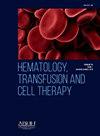评估血清可溶性ST2作为癌症相关静脉血栓栓塞的诊断生物标志物的作用
IF 1.8
Q3 HEMATOLOGY
引用次数: 0
摘要
静脉血栓栓塞是一种与癌症相关的常见并发症,导致发病率和死亡率增加。d -二聚体水平通常在癌症中非特异性升高,这限制了其在诊断静脉血栓栓塞中的应用。本研究旨在探讨血清可溶性抑制致瘤性2 (sST2)作为诊断癌症静脉血栓栓塞的新生物标志物的作用。方法将88例不同类型的癌症患者分为两组:第一组:44例确诊为静脉血栓栓塞的癌症患者;第二组:44例年龄和性别匹配的无血栓并发症的癌症患者。对所有研究对象进行d -二聚体检验和sST2测定。结果I组血清sST2水平显著高于II组(p值<;0.001);I组血清sST2中位数为13.02 ng/mL(范围:7.65-117.9 ng/mL), II组为8.56 ng/mL(范围:5.59-10.33 ng/mL)。血清sST2与d -二聚体水平呈正相关。使用受试者工作特征曲线,sST2的曲线下面积大于d -二聚体试验(分别为0.974和0.869)。虽然d -二聚体检测更敏感,但sST2的特异性比d -二聚体更高(分别为95.45%和27.3%),阳性预测值更高(分别为95.3%和56.8%)。结论目前的研究结果支持可溶性ST2在癌症患者静脉血栓栓塞诊断中的潜在作用。本文章由计算机程序翻译,如有差异,请以英文原文为准。
Evaluation of the role of serum soluble ST2 as a diagnostic biomarker for cancer-associated venous thromboembolism
Introduction
Venous thromboembolism, a common complication associated with cancer, causes increased morbidity and mortality. D-dimer levels are often increased non-specifically in cancer which limits their use to diagnose venous thromboembolism. The current study aimed to investigate the role of the serum soluble suppression of tumorigenicity 2 (sST2) as a new biomarker to diagnose venous thromboembolism in cancer.
Methods
Eighty-eight patients with different types of cancer were enrolled and divided into two groups: Group I: 44 cancer patients with confirmed diagnosis of venous thromboembolism and Group II: 44 age- and sex-matched cancer patients without any thrombotic complications. The D-dimer test and sST2 measurement were performed for all study subjects.
Results
Serum sST2 levels were significantly higher in Group I than in Group II (p-value < 0.001); the median serum sST2 was 13.02 ng/mL (range: 7.65–117.9 ng/mL) in Group I versus 8.56 ng/mL (range: 5.59–10.33 ng/mL) in Group II. There was a significant positive correlation between serum sST2 and the D-dimer level. Using a receiver operating characteristic curve, sST2 had a greater area under the curve than the D-dimer test (0.974 versus 0.869, respectively). Although the D-dimer test was more sensitive, sST2 had a greater specificity than D-dimer (95.45 % versus 27.3 %, respectively) and a higher positive predictive value (95.3 % versus 56.8 %, respectively).
Conclusion
The results of the current study support a potential role of soluble ST2 to aid in diagnosing venous thromboembolism in cancer patients.
求助全文
通过发布文献求助,成功后即可免费获取论文全文。
去求助
来源期刊

Hematology, Transfusion and Cell Therapy
Multiple-
CiteScore
2.40
自引率
4.80%
发文量
1419
审稿时长
30 weeks
 求助内容:
求助内容: 应助结果提醒方式:
应助结果提醒方式:


